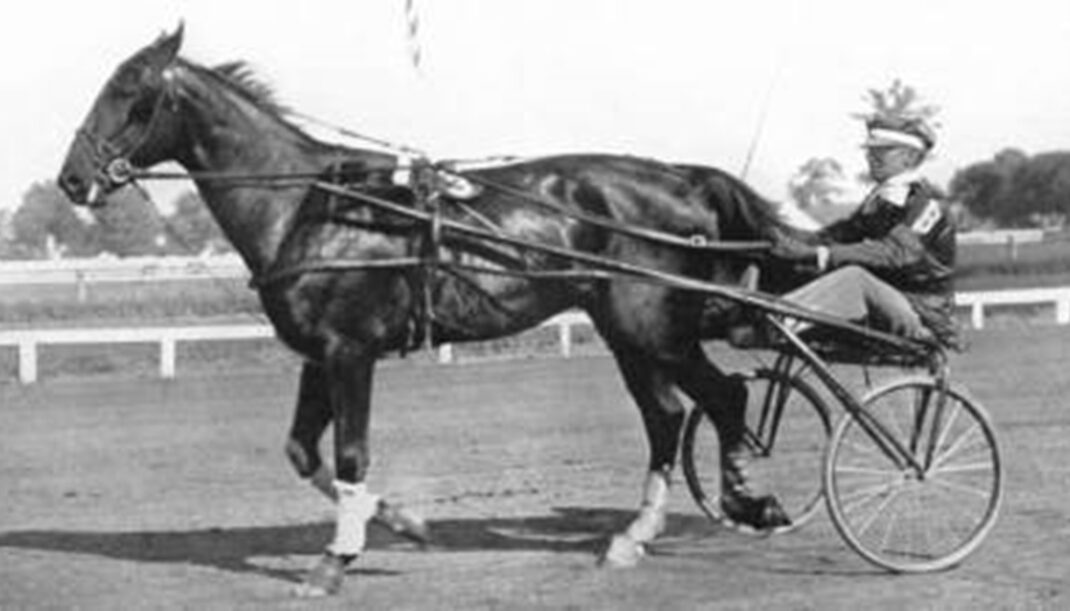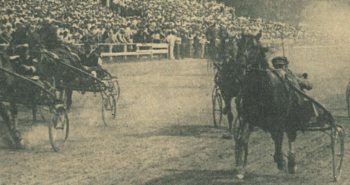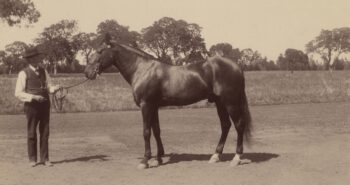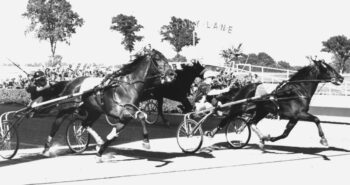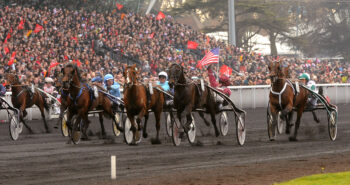The only horse in history to set world records at 1, 2, 3 and 4 before eventually becoming one of the great stallions in history, Peter Volo was a champion both on and off the track. He was not a friendly horse, though, and had a terrible temperament. Though considered one of the pillars of harness racing history, Peter Volo was on track to be forgotten as a stallion given his poor production. One man, however, refused to give up how in the foul-tempered stallion and persisted in his efforts to buy him – a purchase which would change history.
Peter Volo first caught the public’s attention on Aug 16, 1912, when he set a new yearling world record, trotting in 2:19 (1.26,4) at the Blue Grass Fair, occasionally referred to as a “colored fair”, in Lexington. This record would later that year be lowered to 2:15 3/4 (1.24,4) by Airdale, a record that still stands since this was the last year world records by yearlings was recognized. In March 1912 breeder and owner William Earl Dodge (WED) Stokes had sent a consignment of yearlings, including Peter Volo, to a Chicago auction . The “owner’s statement” included the claim that he was the fastest yearling in the world and a future champion. Naturally, owner’s statements are to be taken with a grain of salt but it indicated Stokes’ belief in the trotter. Stokes supposedly had no intention of actually selling Peter Volo in that auction, instead the colt was merely put in as an attraction for the rest of the consignment. When offered he was bid in and returned home to the Patchen Wilkes farm.
Trained by Ed Willis, the superintendent who ran Patchen Wilkes, he was not started as a yearling until he considered Peter Volo ready to beat the existing yearling record of 2:19 1/4 (1.26,6) set by his sister Miss Stokes three years earlier. Trotting the first quarter in 35 and the next in 34, he was pushed further in the third heat which was trotted in 33 1/2 but faded in the fourth quarter, completing it in 37 1/2 for a total time of 2:19 flat (1.26,4). In January Stokes sent the colt to trainer Thomas Murphy in Poughkeepsie. Just a few years earlier, Murphy campaigned the filly Native Belle, world record holder for two-year-olds with 2:07 3/4 (1.19,4) set when she won the Junior Kentucky Futurity.
Undefeated
Yearling races were frowned upon by most of the harness community and many yearling stars failed to follow up in later years. But in his first start in 1913 for Murphy, at Kalamazoo on Aug 5, 1913, Peter Volo set two world records. Winning the first heat in 2:09 (1.20,2) and the second in 2:09 1/4 (1.20,3), he set records for both for fastest two-year-old colt and for the fastest two heats by a two-year-old. According to newspaper reports, “the distance was made with ease, Murphy holding the colt back as he came down the stretch.” Starting in the Horse Breeders’ Futurity at Rockingham Park next, he lost the first heat to Airdale but won the next two comfortably.
Then, in the Horse Review Futurity in Columbus, Ohio on Sept 25, Peter shocked everybody by shattering his own records, now winning in 2:06 1/4 and 2:07 (1.18,5 and 1.18,9). In both heats Lady Wanetka, another daughter of Peter the Great, tried to challenge him but reports make it clear that the result was never in doubt. Lady Wanetka and her trainer-driver Walter Cox made another try in the Junior Kentucky Futurity in Lexington on Oct 7, 1913. After winning the first heat in 2:09 1/4 (1.20,3), Peter Volo again shattered his own world record, this time trotting in 2:04 1/2 (1.17,4).
Lowering world records is nothing new, but Peter Volo lowered it by several seconds. People already started talking about him being a future 2:00 trotter and an obvious future challenger to Uhlan’s 1:58 (1.13,3), set the year before. But along with that talk came ugly rumors that Peter Volo was not a two-year-old, that he really was a three-year-old. Part of this was surely fueled by Peter Volo’s superiority but partly also by the general disdain and distrust of his owner and, on paper, breeder WED Stokes, an extremely controversial figure. But fortunately for the reputation of Peter Volo – and the sport, too – the colt was not a product of Patchen Wilkes Farm or Stokes himself. Nevertheless, the gossip continued for a long time. Despite Peter Volo appearing in the Trotting Register as bred by Patchen Wilkes Farm, he was actually bred by GL Knight of Nicholasville, Kentucky who owned his dam Nervolo Belle. The GL Knight farm would later be known as Almahurst Farm, and Peter Volo was in fact foaled in the very same barn where Greyhound was later born. There was absolutely no doubt that he was foaled in 1911: while nobody trusted Stokes, Knight was universally considered a gentleman of unimpeachable integrity. When Nervolo Belle was bred to Peter the Great it was agreed that WED Stokes, of Patchen Wilkes Farm, and owner of Peter the Great, could buy him as a weanling if he liked the colt. After the colt had set his yearling record Stokes had him registered as bred by Patchen Wilkes Farm. But neither Stokes nor Patchen Wilkes Farm ever owned or leased Nervolo Belle.
Still undefeated
Peter Volo made his three-year-old debut at Kalamazoo. Winning the heats in 2:04 3/4, 2:05 3/4 and 2:06 3/4 (1.17,5, 1.18,2 and 1.18,8), he set two world records – three heats for three-year-olds and three heats for all ages – but he met tough competition from Lee Axworthy. In the first heat Peter Volo went to the lead but Lee Axworthy, driven by Billy Anders, was all over him immediately, forcing a first quarter in 30 1/2 and first half in 1:01. Going by the three-quarters in 1:32 1/2 Lee Axworthy started to tire while Peter just kept on going, hitting the line in 2:04 3/4 (1.17,5), tying Colorado E’s world record for the age. In the second heat Lee Axworthy again tried to tire out Peter Volo, but the same story unfolded with the latter winning in 2:05 3/4 (1.18,2). When Lee did not come back for the third heat, Peter took an easy win in 2:06 3/4 (1.18,8).
The next four races were easy wins for Peter Volo and he finished his season by contesting the Kentucky Futurity. After 9 straight wins in as many starts, his apparent invincibility had scared off all but Lee Axworthy, Lady Wanetka and Ortolan Axworthy. In the first heat things started slowly and Peter in the lead reached the half in a slow 1:06. Andrews then sent Lee Axworthy at Murphy’s colt. Trotting the last half in 1:01 1/4, the last quarter in 29 3/4, Murphy for once had to work behind Peter Volo who still managed to win by a length. In the second half they again started slowly but they went to the half in 1:04 3/4 and raced the last half in 1:00 1/4, Peter Volo lead all the way but barely managed to hang on to win by a neck ahead of Lee Axworthy. The third heat was no different except that Lee Axworthy came at Peter earlier. After a first quarter in 32, Lee Axworthy forced the pace and the second quarted was complete in 30 1/2 and the third in an even faster 29 3/4. As the two turned for home the crowd sat tense with anticipation and excitement. Andrews was driving Lee strenuously, Murphy was apparently sitting still behind Volo, but it could be seen that Peter was extended to his limit. But as they passed the seven-eighths he began to draw away while Lee Axworthy had reached the end of his tether. Andrews saw it was useless and ceased driving him, knowing he had second money won, and Cox brought Lady Wanetka up with a splendid burst of speed, passed him and finished second, not far back of Peter Volo as he thundered under the wire in 2:03 1/2 (1.16,8), lowering the previous three-year-old record by a second and a quarter.
Though his on-track performances were fantastic, certainly not all aspect of Peter was seen as fantastic. He was not described as a pretty horse with his pronounced Roman nose and big bulky frame. His gait was rough. Described as “not a kid’s horse”, he had a mean disposition and was very headstrong. In surviving videos he is seen paraded with two caretakers lead by a chain.
His only loss
As a four-year-old Peter Volo was expected to break the 2:00 barrier and Stokes announced in January that the plan was to break The Harvester’s 2:01 (1.15,2) record, which would make Peter Volo the fastest stallion when he entered stud. In April that year the owners of Lee Axworthy handed a certified cheque for $5,000 to the Trotter and Pacer, challenging the owners of Peter Volo and Etawah to do the same for a $15,000 winners-take-all match race, or a $10,000 race if only one of the two were willing to accept the challenge. Many believe it to be some sort of publicity stunt. After all, Lee had pushed Peter hard in their three-year season, but had never managed to beat him, and Etawah held the three-heat world record. Initially the challenge was rejected by the owners of both horses but in June somebody had a change of heart. Etawah spent the spring at Castleton Farm in the stud with a full book and was in no shape race to race. But eventually the Peter Volo camp decided to accept the challenge from the Pastime Stables, owners of Lee Axworthy, and the time and place was set to August 16 at the North Randall track in Cleveland.
Even though Lee had never beaten Peter the result was not a foregone conclusion in most eyes. According to one newspaper article at the time, “in the opinion of many horseman the meeting of Peter Volo and Lee Axworthy will be more interesting than the meeting of the two great pacers. It is predicted that one mile of their race will lower the world’s record for trotters, which is 2:01 1/4 (1.15,4) and was made over the North Randall track when Hamburg Belle defeated Uhlan.” As a sidenote, the “meeting of the two great pacers” referred to was a match race between William and Directum I.
Peter had never lost to Lee and when the first heat got underway he made it abundantly clear it was not going to happen now either. Leaving faster than Lee, he rocketed to the lead and won by two lengths in a new world record (for four year olds) 2:02 (1.15,8). One newspaper report stated that “Andrews had made the mistake in the first heat of trailing the Murphy stallion and attempting to brush him out in the stretch.” Changing tactics, in the second heat Andrews went all-in from the start, managed to take the pole to which Peter Volo responding by breaking wildly. Lee’s first quarter of 29 3/4 was almost unheard of and when Peter started trotting he spotted him six lengths behind. Closing the gap on the backstretch he was at Lee’s wheel at the three-quarter, but tired badly in the home stretch and the Lee won in 2:03 1/4 (1.16,6). That was it for Peter Volo that day: the third and decisive heat was an easy win for Lee Axworthy, winning in 2:04 1/4 (1.17,2). It would make sense that Peter Volo, making his first start, probably wasn’t in good enough form to run three such fast heats. Lee Axworthy had, after all, come into the match race having started twice already in 1915.
Peter Volo was still being steered toward the magical 2:00 barrier. But in several consecutive time trials he could never trot faster than 2:02. Winning against top opposition in Lexington in October, he posted winning times of 2:02 1/2, 2:02 3/4 and 2:02 (1.16,1, 1.16,3 and 1.15,8). Some now started believing that Peter Volo was hitting the ceiling, 2:02 proving to be the limit of what he was capable of, while some thought the match race against Lee had caused something to happen to him from which he just couldn’t recover. Regardless, at the end of the year Peter Volo was retired to stud at the Patchen Wilkes Farm with 21 wins in 22 starts and earnings of $43,536. Stokes sold off his sire Peter the Great, thus making Peter Volo the undisputed king at the farm and avoiding an internal competition for the mares.
Failing at stud
Despite high expectations, Peter Volo initially showed himself to be a weak stallion. Surprisingly, being owned by WED Stokes was a massive drawback as the wealthy man was universally distrusted and disliked – “disdain” probably being the best word to describe the general attitude. His Wikipedia page contains numerous stories and anecdotes which more than underscores this. One being that when he was 59 years old he was shot and wounded by a 22-year-old woman who claimed Stokes had attacked him. The reason for this was that the woman refused to return compromising letters Stokes had written her – and at trial the woman was acquitted. Six years later, in 1917, to quote the same Wikipedia page, he “wrote The Right to be Well Born; or, Horse Breeding in its Relation to Eugenics which was published by C. J. O’Brien in New York. In this book, Stokes, who was a horse breeder, extended his theories from the equine, advocating selective breeding in humans and the grading of men who are candidates for marriage. He writes that the genealogical records of the working class should be kept so that prospective employers can assess their capabilities. The book was so ill-received that the publishers sued Stokes for the recovery of their costs.”
With this as a backdrop it is easy to understand why many breeders refused to send any mare to Peter Volo, just on the account of his owner. The first foals made their debuts as two-year-olds in 1919 and out of a large crop only three took records and only one, Voltage bettered 2:25 (1.30,1). The next crop was barely better and negative rumors about his get started to spread. Around the same time Patchen Wilkes Farm superintendent Eddie Willis had left his job and the farm, always a “badly conducted breeding establishment” according to John Hervey, went “from worse to worst.” With an owner involved in numerous lawsuits related to his personal and family life, and not providing sufficient funding for the farm, in the end authorities intervened for animal welfare reasons. It was announced the horses belonging to the farm would be sold in an auction during the Lexington meet in October 1920.
Peter Volo stood for five seasons at Patchen Wilkes Farm, from 1916 to 1920 inclusive. In the auction Peter Volo was sold for $35,000 but it soon became apparent he really had been “bought back” by Stokes and was going back to the farm. According to Hervey in an article in Harness Horse, “The admirers of Peter Volo — for in spite of all, he still had many — were in a mournful state of mind. What was to become of this wonderful horse? Nobody seemed to want him. He might as well be dead as at Patchen Wilkes — in fact, he was worse than dead out there. Likely the foreigners might step in and carry him off across the water.
The turnaround
Though nobody appreciated it in its exact light at the time, it was a crisis in breeding history. A critical moment in the progress of the Standard breed. And the man who solved it was Harry Burgoyne. He had been one of the men who had carried the bidding on the horse along. When he did so, he was at once asked if he was bidding for Walnut Hall Farm; and he had answered no, that he was not. It was then understood that he was merely trying to help make the sale a success, and assist in obtaining a decent price for the stallion.
But Mr. Burgoyne wanted him for Walnut Hall — and wanted him badly. He was one of the few men left in Kentucky – JL Dodge was one of the others – who still had faith in Peter Volo. He consulted with Dr. Edwards and found that gentleman agreed with him. And not long after the pseudo-sale at the Tattersall building, Peter Volo wended his way one morning from Patchen Wilkes Farm over the pikes to Walnut Hall, his future home. The price paid for him was never officially published but the authentic price was believed to be $30,000.”
Peter Volo would spend 16 years at Walnut Hall. The first crop bred there was nothing special, but the second Walnut Hall-bred crop brought Peter Maltby 2, 2:06 1/4 (1.18,5) and would later be followed by horses like Volomite and Hambletonian winners Hanover’s Bertha, The Marchioness and Peter Astra. He also sired a Prix d’Amerique-winner in DeSota, winner of that race in both 1938 and 1939. Peter Volo died on Nov 7, 1936, at which time he was considered one of the great stallions, and is buried at Walnut Hall Farm. He was inducted into the Hall of Fame in 1953.
Peter Volo
Bay colt born in Nicholasville, KY in 1911. Died in Lexington, KY on Nov 7, 1936.
Peter the Great – Nervolo Belle (Nervolo)
22 starts: 21-1-0 – 4,2:02 (1.15,8) – $43,536
Breeder: GL Knight, though officially listed (incorrectly) as bred by Patchen Wilkes Farm
Owners: WED Stokes, Walnut Hall Farm
Trainers: Ed Willis, Thomas Murphy
Drivers: Ed Willis, Thomas Murphy
Groom: –

